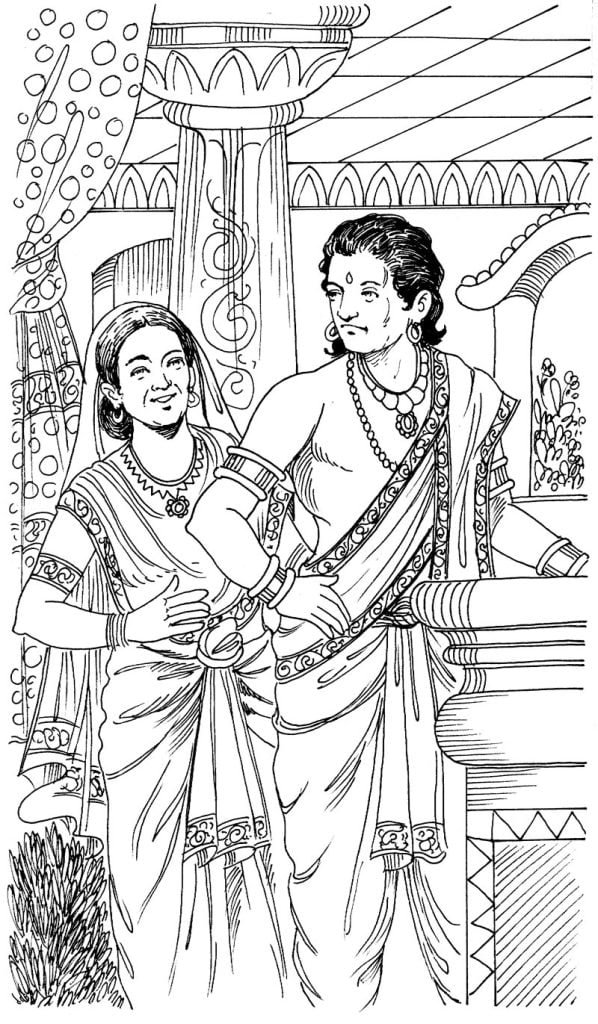Just as Jeejabai inspired her son Shivaji into becoming defender of the native land and faith, Kishori Rani inspired her son in the defence of Bharatpur state.
Bharatpur is situated 200 kms off Delhi on the boundaries of Rajasthan and U.P. It is a town and a state of the same name. It was a princely state during the British Raj and perhaps the only state in India ruled by Jat kings. Surajmal was the most glorious of the Jat kings. Kishori Rani was his queen.
There is a small town called Hodal near Palwal on U.P.-Haryana border. Kishoridevi was the daughter of a commoner named Chaudhary Kashiram of Hodal and she went on to become Rani Kishori. The marriage was a also the result of an uncommon incident. Hodal was big village of Bharatpur State. Crown prince Surajmal was on a visit to the village. He led a procession sitting atop an elephant. The people stood on both sides of the path to hail the prince. The path had been cleared of the people by the soldiers. Suddenly, a teenager girl jumped in and stood on the way. The soldiers warned her, “Hey girl! Get out of the way. Can’t you see the crown prince is coming?”
The girl did not move and stood her ground. In her rough rustic lingo she said, “The path is wide open. The elephant of prince can pass by on left or right. If the prince does not like village folk why does he come here at all? I stand here. You take your elephant through on my left or right.” Atop his elephant the prince Surajmal was listening to the argument between the soldiers and the village girl. The courage and the logic of the girl impressed the crown prince. Through his body guard he got the information about the parents of that girl. After reaching Bharatpur he sent his marriage proposal with Kishoridevi to her father Chaudhary Kashiram.

Then, the royals had a custom that if due to some reason a king or a prince was unable to go to his fiancee’s abode for marriage he would send his head scarf and the personal dagger with a messenger. The marriage ritual would take place as those two items symbolically representing the royal groom. As Kishori’s father was not rich enough to afford the expenses of hosting a prince, Surajmal too sent his dagger and head scarf. But Kishori took it as an affront to her and got his father send a message that to marry Kishoridevi prince Surajmal must come himself to go through marriage rituals. Prince Surajmal duly arrived at Hodal and married Kishori to take her to Bharatpur as his bride.
After some time Surajmal descended on the throne. He had another senior queen named Ganga. Kishori was his second queen. Ganga had two sons named Jawahar singh and Ratansingh. Kishori had no issue, she adopted the elder son of queen Ganga. Later, her adopted son Jawaharsingh inherited the throne.
Raja Surajmal of Bharatpur was a very courageous and brave ruler like Rana Pratap and Shivaji. In 1760, when Moghuls were reigning supreme, Surajmal attacked Agra and seized the fort. Three years later in 1763 he raided Delhi. A fierce battle followed. Raja Surajmal lost his life. Although he couldn’t win Delhi yet he put enough fear in Moghuls who never dared to cast evil eye on Bharatpur. After his death Jawaharsingh became the ruler and wore crown. But he was incompetent, idler and a man of indulgences. He neglected the affairs of the state. Balram was the chief commander of the Bharatpur forces. He took over the posts of the chief minister and treasurer too. He had become a real power of Bharatpur. His next aim was to dethrone Jawaharsingh and become the king.
The people were not happy with the carelessness and indulgences of Jawaharsingh. Kishori Rani had to do something to control the damage and set things right. She reasoned with Jawaharsingh and urged him to mend his ways. Kishori Rani was illiterate but she had a wise head. Very efficient and clever she was. She intervened and cut the wings of Balram. After cutting him to size Kishori forced her adopted son to take care of the affairs of the state. Infact, she was the one who was running the state for her son. She kept urging Jawaharsingh to complete the task left unfinished by his father who had made unsuccessful attempt at seizing Delhi. She wanted him to attack Delhi. There was little money in treasury. Kishori sold all her jewellery and raised money from the merchants on credit. Jawaharsingh launched an attack on Delhi and inflicted heavy casualties on Moghuls. A big part of Moghul treasury he was able to seize and return to Bharatpur. Thus, she was instrumental in getting the unfinished task of her husband completed by his son.
Then, Raja Jawaharsingh died. His younger brother Ratansingh sat on throne. The real heir to the throne was Ranjitsingh, the son of Jawaharsingh. The palace and the court had got divided in two camps. Taking advantage of it commander Dansingh had increased his power considerably. Again Kishori Rani intervened, put Dansingh in his place and banished disunity and infighting. Ratansingh had died and his 1½ year old son was put on the throne. Again Kishori Rani was ruling state on behalf of the infant king. It was the third generation of Bharatpur’s Jat royal family she was guiding along. To save the state from the conspiracies of Dansingh, Kishori Rani removed him from the commander’s post. A loyal commander named Ranjitsingh was appointed chief of the Bharatpur army. Now state was totally in control of Kishori Rani.
Meanwhile, Moghuls got wind of the internal strife in the royal family of Bharatpur. Commander Nazaf Khan moved with a large force and attacked Bharatpur. Then Kishori Rani was an old lady of 65 years and on the throne sat a child. But Kishori would not give up. She rallied Bharatpur forces and sent commander Ranjitsingh to deal with the Moghuls. From the fort of Bharatpur she was directing her forces in the battle through her inspiration and indomitable spirit. She had briefed her commander the strategies to be adopted and the battle plan. Bharatpur army defeated the Moghul force and returned victorious.
Meanwhile, over the period Chhatrapati Shivaji had turned Marathas into a great fighting force and it was dominating the post-Aurangzeb scene in north India. Although his sons turned out to be incompetent yet the battling spirit infused by him was throwing up great battlers and fighting units. Peshwas had made Marathas into a force to reckon with. They ruled upto Gwalior. Scindias of Gwalior were centre of Maratha power in the north. In 1784, Scindia attacked Bharatpur and gained control over it. Now a diplomatic dimension of Kishori Rani came to the fore. She met Scindia and forged brother-sister relationship with him. Scindia returned leaving Bharatpur again a free state. It remained an independent state till the independence of India when it voluntarily became a part of the Indian union. In size, former Bharatpur kingdom constitutes merely a district of present day state of Rajasthan but its glorious history vies with Mewar and Boondi. It is a name that evokes reverence in those who know history and Kishori Rani its star brilliant.
Like Meerabai, Rani Kishori was also an ardent devotee of Lord Krishna. Several temples she constructed and many of them reconstructed out of ruins or got them renovated. The magnificent Kishori Shyam temple of Govardhan was her creation. She got a palace built on the bank of Manasi Ganga.
She gave due honour to poets, writers, musicians, artists and the men of religion although she was herself illiterate and of rustic background. Kishori Rani got several schools opened in Bharatpur.
So, in the folklore of Bharatpur Kishori Rani is a legendary figure. After reading about the story of her life the readers will also realise how exceptionally wise and brave a village girl named Kishori turned out to be.
